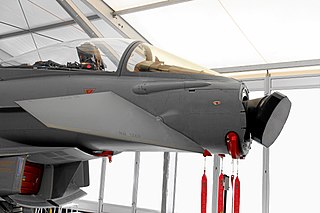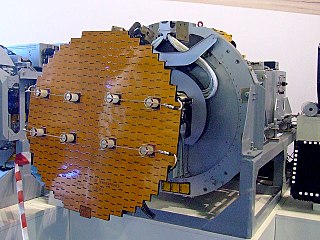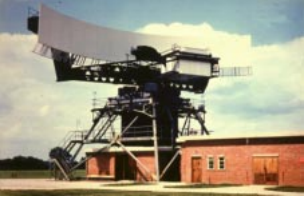
Radar is a system that uses radio waves to determine the distance (ranging), direction, and radial velocity of objects relative to the site. It is a radiodetermination method used to detect and track aircraft, ships, spacecraft, guided missiles, motor vehicles, map weather formations, and terrain.

In telecommunication, especially radio communication, spread spectrum are techniques by which a signal generated with a particular bandwidth is deliberately spread in the frequency domain over a wider frequency band. Spread-spectrum techniques are used for the establishment of secure communications, increasing resistance to natural interference, noise, and jamming, to prevent detection, to limit power flux density, and to enable multiple-access communications.

An active electronically scanned array (AESA) is a type of phased array antenna, which is a computer-controlled antenna array in which the beam of radio waves can be electronically steered to point in different directions without moving the antenna. In the AESA, each antenna element is connected to a small solid-state transmit/receive module (TRM) under the control of a computer, which performs the functions of a transmitter and/or receiver for the antenna. This contrasts with a passive electronically scanned array (PESA), in which all the antenna elements are connected to a single transmitter and/or receiver through phase shifters under the control of the computer. AESA's main use is in radar, and these are known as active phased array radar (APAR).
Beamforming or spatial filtering is a signal processing technique used in sensor arrays for directional signal transmission or reception. This is achieved by combining elements in an antenna array in such a way that signals at particular angles experience constructive interference while others experience destructive interference. Beamforming can be used at both the transmitting and receiving ends in order to achieve spatial selectivity. The improvement compared with omnidirectional reception/transmission is known as the directivity of the array.

A pulse-Doppler radar is a radar system that determines the range to a target using pulse-timing techniques, and uses the Doppler effect of the returned signal to determine the target object's velocity. It combines the features of pulse radars and continuous-wave radars, which were formerly separate due to the complexity of the electronics.
Electronic counter-countermeasures (ECCM) is a part of electronic warfare which includes a variety of practices which attempt to reduce or eliminate the effect of electronic countermeasures (ECM) on electronic sensors aboard vehicles, ships and aircraft and weapons such as missiles. ECCM is also known as electronic protective measures (EPM), chiefly in Europe. In practice, EPM often means resistance to jamming. A more detailed description defines it as the electronic warfare operations taken by a radar to offset the enemy's countermeasure.
A low-probability-of-intercept radar (LPIR) is a radar employing measures to avoid detection by passive radar detection equipment while it is searching for a target or engaged in target tracking. This characteristic is desirable in a radar because it allows finding and tracking an opponent without alerting them to the radar's presence. This also protects the radar installation from anti-radiation missiles (ARMs).
Radar jamming and deception is a form of electronic countermeasures that intentionally sends out radio frequency signals to interfere with the operation of radar by saturating its receiver with noise or false information. Concepts that blanket the radar with signals so its display cannot be read are normally known as jamming, while systems that produce confusing or contradictory signals are known as deception, but it is also common for all such systems to be referred to as jamming.
Linesman/Mediator was a dual-purpose civil and military radar network in the United Kingdom between the 1960s and 1984. The military side (Linesman) was replaced by the Improved United Kingdom Air Defence Ground Environment (IUKADGE), while the civilian side (Mediator) became the modern public-private National Air Traffic Services (NATS).
A radar system uses a radio-frequency electromagnetic signal reflected from a target to determine information about that target. In any radar system, the signal transmitted and received will exhibit many of the characteristics described below.
Radar engineering is the design of technical aspects pertaining to the components of a radar and their ability to detect the return energy from moving scatterers — determining an object's position or obstruction in the environment. This includes field of view in terms of solid angle and maximum unambiguous range and velocity, as well as angular, range and velocity resolution. Radar sensors are classified by application, architecture, radar mode, platform, and propagation window.
Frequency agility is the ability of a radar system to quickly shift its operating frequency to account for atmospheric effects, jamming, mutual interference with friendly sources, or to make it more difficult to locate the radar broadcaster through radio direction finding. The term can also be applied to other fields, including lasers or traditional radio transceivers using frequency-division multiplexing, but it remains most closely associated with the radar field and these other roles generally use the more generic term "frequency hopping".

The AMES Type 82, also widely known by its rainbow codename Orange Yeoman, was an S-band 3D radar built by the Marconi Company and used by the Royal Air Force (RAF), initially for tactical control and later for air traffic control (ATC).
Angle deception jamming is an electronic warfare technique used against conical scanning radar systems. It generates a false signal that fools the radar into believing the target is to one side of the boresight, causing the radar to "walk away" from the target and break its radar lock-on. It is also known as angle walk-off, angle stealing, or inverse con-scan.

RX12874, also known as the Passive Detection System (PDS) and by its nickname "Winkle", was a radar detector system used as part of the Royal Air Force's Linesman/Mediator radar network until the early 1980s. Winkle passed out of service along with the rest of the Linesman system as the IUKADGE network replaced it.

The AMES Type 85, also known by its rainbow code Blue Yeoman, was an extremely powerful early warning (EW) and fighter direction (GCI) radar used by the Royal Air Force (RAF) as part of the Linesman/Mediator radar network. First proposed in early 1958, it was eleven years before they became operational in late 1968, by which time they were already considered obsolete. The Type 85 remained the RAF's primary air defense radar until it was replaced by Marconi Martello sets in the late-1980s as part of the new IUKADGE network.
The railSAR, also known as the ultra-wideband Foliage Penetration Synthetic Aperture Radar, is a rail-guided, low-frequency impulse radar system that can detect and discern target objects hidden behind foliage. It was designed and developed by the U.S. Army Research Laboratory (ARL) in the early 1990s in order to demonstrate the capabilities of an airborne SAR for foliage and ground penetration. However, since conducting accurate, repeatable measurements on an airborne platform was both challenging and expensive, the railSAR was built on the rooftop of a four-story building within the Army Research Laboratory compound along a 104-meter laser-leveled track.
The Spectrally Agile Frequency-Incrementing Reconfigurable (SAFIRE) radar is a vehicle-mounted, forward-looking ground-penetrating radar (FLGPR) system designed to detect buried or hidden explosive hazards. It was developed by the U.S. Army Research Laboratory (ARL) in 2016 as part of a long generation of ultra-wideband (UWB) and synthetic aperture radar (SAR) systems created to combat buried landmines and IEDs. Past iterations include the railSAR, the boomSAR, and the SIRE radar.
The AMES Type 84, also known as the Microwave Early Warning or MEW, was a 23 cm wavelength early warning radar used by the Royal Air Force (RAF) as part of the Linesman/Mediator radar network. Operating in the L-band gave it improved performance in rain and hail, where the primary AMES Type 85 radar's performance dropped off. It operated beside the Type 85 and RX12874 in Linesman, and moved to the UKADGE system in the 1980s before being replaced during UKADGE upgrades in the early 1990s.
The AR-320 is a 3D early warning radar developed by the UK's Plessey in partnership with US-based ITT-Gilfillan. The system combined the receiver electronics, computer systems and displays of the earlier Plessey AR-3D with a Gilfillan-developed transmitter and planar array antenna from their S320 series. The main advantage over the AR-3D was the ability to shift frequencies to provide a level of frequency agility and thus improve its resistance to jamming.







